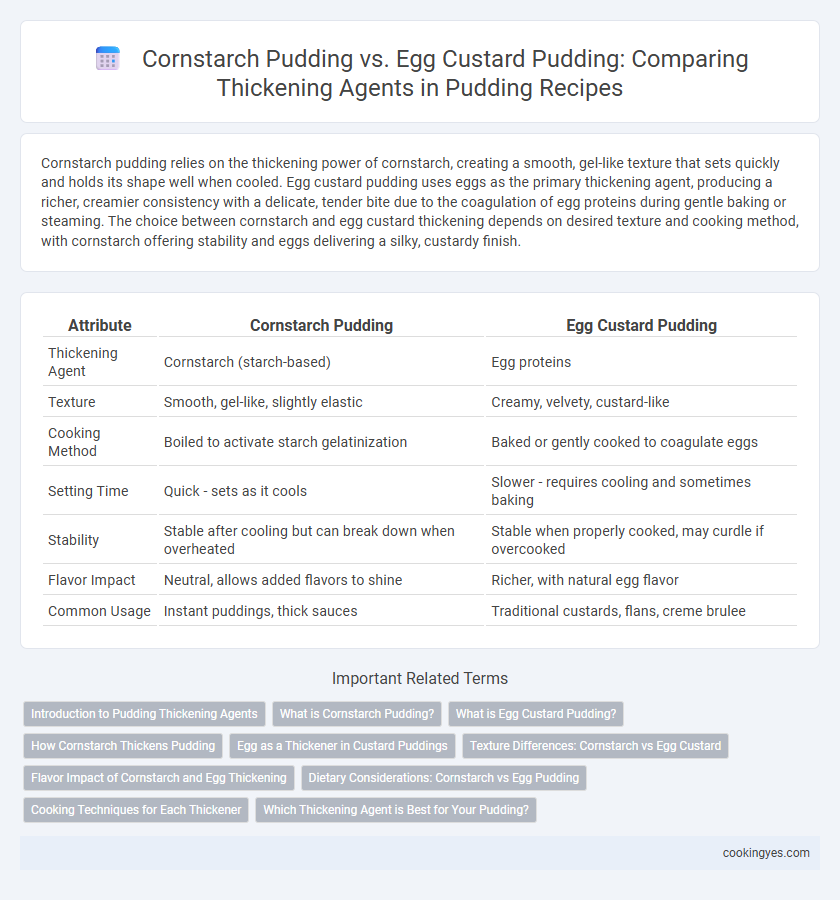Cornstarch pudding relies on the thickening power of cornstarch, creating a smooth, gel-like texture that sets quickly and holds its shape well when cooled. Egg custard pudding uses eggs as the primary thickening agent, producing a richer, creamier consistency with a delicate, tender bite due to the coagulation of egg proteins during gentle baking or steaming. The choice between cornstarch and egg custard thickening depends on desired texture and cooking method, with cornstarch offering stability and eggs delivering a silky, custardy finish.
Table of Comparison
| Attribute | Cornstarch Pudding | Egg Custard Pudding |
|---|---|---|
| Thickening Agent | Cornstarch (starch-based) | Egg proteins |
| Texture | Smooth, gel-like, slightly elastic | Creamy, velvety, custard-like |
| Cooking Method | Boiled to activate starch gelatinization | Baked or gently cooked to coagulate eggs |
| Setting Time | Quick - sets as it cools | Slower - requires cooling and sometimes baking |
| Stability | Stable after cooling but can break down when overheated | Stable when properly cooked, may curdle if overcooked |
| Flavor Impact | Neutral, allows added flavors to shine | Richer, with natural egg flavor |
| Common Usage | Instant puddings, thick sauces | Traditional custards, flans, creme brulee |
Introduction to Pudding Thickening Agents
Cornstarch pudding relies on the gelatinization of starch granules to thicken, producing a smooth and stable texture that sets upon cooling. Egg custard pudding uses egg proteins coagulating under heat to create a rich and creamy consistency, which can be more delicate and sensitive to overcooking. Understanding these thickening mechanisms is essential for selecting the appropriate method to achieve the desired pudding texture and stability.
What is Cornstarch Pudding?
Cornstarch pudding is a smooth, creamy dessert thickened primarily with cornstarch, which acts as a starch-based thickening agent by gelatinizing when heated with liquid. Unlike egg custard pudding, which relies on the coagulation of eggs for texture, cornstarch pudding provides a consistent, stable firmness without the risk of curdling. This makes cornstarch pudding ideal for recipes requiring a velvety mouthfeel and reliable thickness, particularly in dairy or non-dairy bases.
What is Egg Custard Pudding?
Egg custard pudding is a creamy dessert thickened primarily with eggs, which coagulate during baking to create a smooth, firm texture. Unlike cornstarch pudding, which uses starch to thicken through gelatinization, egg custard relies on protein denaturation for its structure. This method produces a rich, velvety consistency and a delicate flavor profile unique to egg-based custards.
How Cornstarch Thickens Pudding
Cornstarch thickens pudding by gelatinizing when heated with liquid, causing its starch granules to absorb water and swell, resulting in a smooth, glossy texture that sets firmly upon cooling. Unlike egg custard pudding, which relies on protein coagulation for thickening, cornstarch provides a more stable consistency that resists curdling and can be cooked to a higher temperature without risking separation. This makes cornstarch pudding ideal for achieving a silky mouthfeel while maintaining a cleaner, starch-based thickening process.
Egg as a Thickener in Custard Puddings
Eggs serve as the primary thickening agent in custard puddings, providing a rich, creamy texture through the coagulation of proteins when gently heated. Unlike cornstarch pudding, which relies on starch gelatinization for thickening, egg custards develop a smooth, velvety consistency and delicate structure without a gummy feel. The unique protein network formed by eggs traps moisture effectively, resulting in a custard that holds its shape while maintaining a tender mouthfeel.
Texture Differences: Cornstarch vs Egg Custard
Cornstarch pudding achieves a smooth, gelatinous texture by thickening through starch granule swelling, resulting in a slightly firmer and more stable consistency. Egg custard pudding relies on protein coagulation from eggs, producing a creamier, silkier texture with a delicate, melt-in-the-mouth quality. The choice of thickening agent directly influences the mouthfeel and firmness, with cornstarch providing sturdiness while egg custard offers softness and richness.
Flavor Impact of Cornstarch and Egg Thickening
Cornstarch in pudding creates a smooth, neutral base that enhances other flavors without overpowering them, offering a silky texture ideal for fruit or chocolate varieties. Egg custard pudding delivers a richer, creamier mouthfeel with a distinct eggy flavor that adds depth and complexity, often complementing vanilla or caramel profiles. The choice between cornstarch and eggs as thickening agents significantly influences the pudding's flavor intensity and overall sensory experience.
Dietary Considerations: Cornstarch vs Egg Pudding
Cornstarch pudding offers a vegan-friendly alternative with no cholesterol, making it suitable for individuals with dietary restrictions or egg allergies. Egg custard pudding provides higher protein content and essential vitamins like B12 but may pose challenges for lactose-intolerant or cholesterol-sensitive consumers. Choosing between cornstarch and egg custard puddings depends on dietary needs such as veganism, cholesterol levels, and allergen avoidance.
Cooking Techniques for Each Thickener
Cornstarch pudding requires constant stirring and gradual heating to activate the starch granules, ensuring a smooth, glossy texture without lumps, while temperature control prevents curdling. Egg custard pudding relies on gentle baking or low-temperature stovetop cooking to coagulate the proteins slowly, creating a creamy, delicate consistency without overcooking or scrambling. Mastery of these distinct thickening techniques is essential for achieving the desired pudding texture and flavor profile.
Which Thickening Agent is Best for Your Pudding?
Cornstarch offers a smooth, glossy texture and is ideal for quick, stable puddings that hold shape well without the risk of curdling. Egg custard pudding relies on eggs as a thickening agent, providing a rich, creamy texture with a delicate, melt-in-the-mouth consistency but requires careful temperature control to avoid scrambling. For a foolproof, consistently thick pudding, cornstarch is best, while egg custard pudding excels in flavor and richness when properly prepared.
Cornstarch pudding vs Egg custard pudding for thickening agents Infographic

 cookingyes.com
cookingyes.com